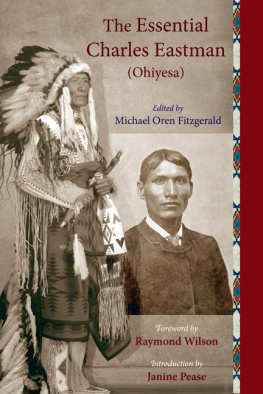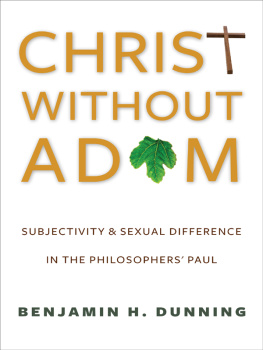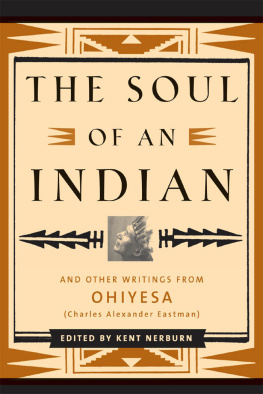Paul and the Person
Reframing Pauls Anthropology
Susan Grove Eastman
WILLIAM B. EERDMANS PUBLISHING COMPANY
GRAND RAPIDS, MICHIGAN
Wm. B. Eerdmans Publishing Co.
2140 Oak Industrial Drive NE, Grand Rapids, Michigan 49505
www.eerdmans.com
2017 Susan Grove Eastman
All rights reserved
Published 2017
26 25 24 23 22 21 20 19 18 171 2 3 4 5 6 7 8 9 10
ISBN 978-0-8028-6896-1
eISBN 978-1-4674-4839-0
Library of Congress Cataloging-in-Publication Data
Names: Eastman, Susan Grove, 1952 author.
Title: Paul and the person : reframing Pauls anthropology / Susan Grove Eastman.
Description: Grand Rapids : Eerdmans Publishing Co., 2017. | Includes bibliographical references and index.
Identifiers: LCCN 2017014597 | ISBN 9780802868961 (pbk. : alk. paper)
Subjects: LCSH: Theological anthropologyChristianity. | Bible. Epistles of PaulTheology. | Bible. Epistles of PaulCriticism, interpretation, etc.
Classification: LCC BS2655.A58 E26 2017 | DDC 233.092dc23
LC record available at https://lccn.loc.gov/2017014597
For Eddie
Contents
Susan Eastman is an intellectual explorer. From the familiar terrain of Pauls statements about humanity she has gone in search of concepts, frames of reference, and models of personhood that could help us make sense of Paul. She has traveled far, into philosophy (ancient and modern), neuroscience, and experimental psychologymostly territory unknown to biblical scholarsand she has returned in triumph. The book before you offers genuinely fresh insights into some of the most difficult material in Pauls letters, while giving us new ways of conceiving what it might mean in contemporary terms.
Pauls complex anthropological terminology (flesh, body, spirit, mind), his unique configuration of the human condition (as both sinners and under Sin), and his innovative language of participation (in Christ, Christ in me) have drawn his interpreters into a long and deep conversation with his letters. Platonist, Stoic, Aristotelian, and existentialist philosophies have all been deployed as intellectual frames in which to make sense of Pauls anthropology, some more successfully than others. The truth is that, without a conceptual framework that makes some sense to us, we end up merely repeating Pauls language without understanding it. Rudolf Bultmanns brilliant attempt in the mid-twentieth century to interpret Pauls anthropology in Lutheran-existentialist terms now feels outdated, not least since its individualist assumptions clash with more recent relational understandings of the self. Ernst Ksemann was already moving in a promising direction, with his understanding of the body as the self-in-relation, but what has been lacking for some forty years has been a coherent, well-researched reading of Pauls anthropology that draws on contemporary insights into what constitutes us as persons and what shapes our identities as embodied agents. Eastman has now filled this significant gap.
Of course there is no single contemporary understanding of the human being, and within each disciplinary field there are strong disagreements and multiple points of difference. What Eastman has discerned, however, is a significant convergence in key aspects of contemporary research, a convergence sufficiently close to core features of Pauls language to provide exciting new possibilities for interpretation. Through her explorations of developmental psychology, neuroscience, and the philosophy of personhood, she has identified common, or at least overlapping, insights into the self as irreducibly embodied and socially formed. In what she labels the second-person perspective, the self is formed not alone in self-referential cognition (a first-person I), nor in objective knowledge of things beyond oneself (a third-person he/she, it, or they), but in encounter with others, in the I-you address where relationships are not additional to the already-formed individual but are constitutive of the person. In other words, old models of individual autonomy are defunct, even if they persist in the popular imagination of the West; we become individuals only in and from relationships, good or bad.
Can this perspective help us make better sense of the way Paul talks of sin as not just something we do but something that shapes us (as in Romans 7)? Can it shed light on Pauls perplexing language of participation in Christ (as in Galatians 2)? Can it draw Pauline studies into better dialogue with contemporary theology, which is already in interdisciplinary conversation along the lines explored here? As the following pages show, the answer to all these questions is a resounding Yes! What Eastman offers here is not an explanation of Pauls anthropology, as if what he wrote is nothing other than what contemporary psychologists or philosophers are saying about the human person. Nor is it an anachronistic imposition on the Pauline texts, since she is careful to give those texts their own voice and to place them also in illuminating comparison with ancient philosophy, in the person of Epictetus. Rather, Eastman stages what she terms a conversation between Paul and contemporary perspectives on the person, a dialogue that helps us identify contemporary models or metaphors that fit both the Pauline texts and our own best understandings of who we are as embodied, relational creatures.
The fit does not require complete similarity, and it retains the integrity of Pauls God-talk. But it sheds significant new light on puzzling Pauline texts, andthis is rightly of importance to Eastmanit enables us to communicate this element of Pauls gospel in terms that resonate with the thought and experience of our contemporaries. There never will be a last word on Pauls anthropology, because the task of interpretation is fresh in each generation and in each new context. But this book does give us rich new insight into Paul and well-conceived language with which to communicate his theology effectively today. That is a precious gift indeed.
JOHN M. G. BARCLAY
Lightfoot Professor of Divinity Durham University
The writing of this book has been a long journey, with many twists and turns along the way. It reflects a persistent fascination with the question of how Pauls gospel intersects with the vicissitudes of daily life, a fascination that brings me back again and again to questions about Pauls understanding of personhoodin short, his anthropology. My interest in what I might call participatory identity grew out of an earlier project on imitation language in Galatians. I began to consider ways in which mimesis was related to participation in the ancient world, and to mull over the nonvolitional aspects of mimesis in human experience. That curiosity about imitation and participation took me considerably beyond the bounds of New Testament scholarship, first into studies of imitation in infants, and eventually into the fascinating discoveries of mirror neurons in a research lab in Parma, Italy. I began to see imitation as a largely unconscious medium of exchange through which we take parts of people into ourselves via a process of mimetic internalization, and they return the favor. This process happens between parents and children, but not only there. Indeed, as my students often tell me, once we have been alerted to the human propensity to imitate others and the neurological underpinnings of that propensity, we see it everywhere.
At the same time, I noticed the strong links between mimesis and participation in the ancient world, beginning with Plato and Aristotle but finding distinctive articulation in the first century in the Stoic philosophers. I began to suspect that my real topic was the language of participation in Paul, particularly the way in which a participatory account of human personhood might help make sense of Pauls puzzling use of the prepositions in and with. Hence my turn to the topic of Pauls anthropology, including his assumed understanding of what it is to be a human being, what makes for suffering, what makes for flourishing, and how people change completely and yet remain themselves. My wrestling with these questions juxtaposes Paul, his ancient context, and contemporary theorists of the person in philosophy and the cognitive sciences.










